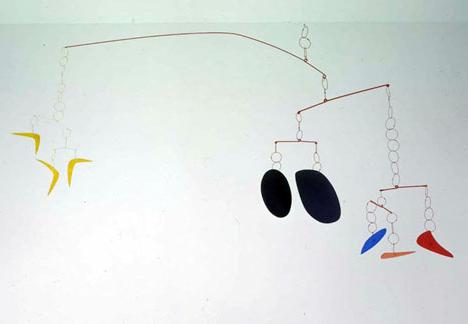Alexander Calder
dal 12/4/2005 al 21/5/2005
Segnalato da
12/4/2005
Alexander Calder
Thomas Dane Gallery, London
Rare works from the 1940s

"The next step in sculpture is motion."
Alexander Calder, New York World-Telegram, June 11, 1932.
"...my first work in the abstract was based on the concept of stellar relationships. Since then there have been variations from this theme, but I always seem to come back to it....†A Propos of Measuring a Mobile, Alexander Calder, unpublished MSS, 1943, Calder Foundation, New York
"The idea of detached bodies floating in space... seems to me the ideal source of form.†Alexander Calder, Museum of Modern Art Bulletin, Vol. 18, no. 3, Spring 1951.
The Directors of Thomas Dane are delighted to present rare works from the 1940s by the American artist Alexander Calder (1898-1976), in an exhibition organised in collaboration with Bortolami Dayan, New York and with the assistance of the Calder Foundation. Focusing on his work of the 1940s, it will be the first solo exhibition of works by Calder to be held in London for 13 years.
Alexander Calder is regarded as one of the great formal innovators of the 20th century. His "mobiles†(a name coined for them by Marcel Duchamp in 1931) were at first motorised and then evolved into the suspended sculptures that move in response to the air, for which he is best known. His "stabilesâ€, as Jean Arp called them, were floor-standing sculptures that often employed sheet metal applied at different angles, inviting the viewer to move around them. Calder continued to develop both these key forms throughout his career and also introduced a hybrid, the "standing mobileâ€, consisting of a fixed base with hanging elements.
In the early 1940s, partly in response to the difficulty of acquiring sheet metal during wartime, he devised the "constellation†– a new kind of structure with wooden forms, attached to the end of steel wires and set on a freestanding base or fixed to a wall.
Having first made jewellery as a child, for his sister’s dolls, Calder continued this practice throughout his life and, in the early 1940s, exhibited a significant body of work in this form. He also made a large number of ink drawings, oil paintings and gouaches, which achieved a notable brilliance from the mid 1940s.
The 1940s, certainly one of his most prolific periods, was also perhaps the most complete decade of Calder’s long artistic life. He explored all the principal forms of his oeuvre in these years, which spanned both wartime, when materials were restricted, and the post-war period when the availability of metal allowed his work to become larger and more exuberant again. In the late 1940s, as a world-famous artist, he undertook ambitious commissions both at home in America and in Europe, where he had first discovered abstraction many years before.
The exhibition at Thomas Dane will include important hanging and standing mobiles, constellations, table pieces, ink drawings and gouaches and jewellery, all from the 1940s. Many of the works have previously been included in historic museum shows.
Boomerangs (1941), for example, is a hanging mobile of sheet metal and wire that perfectly illustrates the artist’s desire to create art in motion. Painted in the primary, secondary and ‘non-colours’ of red, blue, yellow, orange and black that the artist favoured, the piece combines solid volumes with delicate rings and curved shapes. It has been shown in major museums around the world.
A lyrical assemblage of materials including hand-carved ebony, wire and paint, Constellation with Bottles (1943) is one of a group of "constellations†constructed between 1942 and 1943. It was made in the year that Calder became the youngest artist ever to be granted a retrospective at the Museum of Modern Art in New York. Meanwhile, Black Skeleton (c.1945) is an exquisitely rocking stabile, made with sheet metal and paint.
The largest of the works on show is More Extreme Cantilever (1949). Realised in the same year as the great International Mobile, now in the Museum of Fine Arts, Houston, this monumental standing mobile was last exhibited in London at the Tate Gallery in 1962, in a retrospective exhibition of the artist’s work.
Though an American artist, born in Philadelphia, Calder’s closest affinities were with European artists such as Piet Mondrian and Joan Miró. He lived both in the USA and in France, and died in New York in 1976.
CALDER – THE FORTIES will be accompanied by a fully-illustrated 52-page catalogue. Published by Thomas Dane, London and Bortolami Dayan, New York, it will be available for sale from the gallery at £10.00.
Thomas Dane would like to thank the artist’s grandson and Director of the Calder Foundation, Alexander S. C. Rower for his support and collaboration in all aspects of this exhibition.
For press enquiries, please contact Martine d’Anglejan-Chatillon
For information about the Calder Foundation, please visit http://www.calder.org
Thomas Dane
11 Duke Street St James’s London SW1Y 6BN



